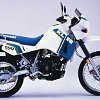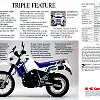The venerable Kawasaki KLR650 is finally being put out to pasture.
At the end of September, an image of a letter began circulating that sure looks a lot like one Kawasaki might send out. This letter, supposedly signed by Bill Jenkins, Senior Vice President of Sales Operations at Kawasaki Motors Corp., U.S.A., was heavily obliterated by the poster. The visible portions contain verbiage stating that the KLR 650 is not eligible for any sales incentives because “Model year 2018 will be the final year for this iconic motorcycle.”

I got back on the case a bit later and found the photo of the letter was actually posted not by some internet wag with an axe to grind, but by an individual posting on Facebook under the account of a Kawasaki dealership. The post’s author originally shot a photo of a KLR at the dealership with a caption lamenting the loss of the KLR650. When someone expressed disbelief that the KLR could be discontinued, the author, presumably a dealership employee, posted a grainy photo of the letter with portions heavily redacted.
A Kawasaki representative from their media division offered no comment when I queried about the KLR being discontinued. Wouldn’t you think they’d put a rumor like that to rest if it was incorrect? While there is no official word from Kawasaki on this matter, the writing appears to be on the wall for the mighty thumper.

Why the end of the KLR650?
The KLR had an impressive run at 32 model years. The bike received updates, most notably a refresh for 2008, but remained very true to the original concept of a big, trail-worthy single that was also adept at pavement work. When it rolled out, the KLR was a modern design with similar contemporaries like the Suzuki DR650 and Honda XR650L. The KLR was simple, reliable, affordable, and offered lots of motorcycle per dollar. And of course, it’s been on sales floors forever.
It’s those very characteristics that made the KLR an instant stalwart in the dual-sport category. Many think of it as the quintessential bulletproof, do-anything adventure bike. The long life meant a sea of aftermarket, used OEM and factory replacement parts were seemingly always available for a song. There have probably been more international discovery rides taken by Americans aboard a KLR than almost any other motorcycle. If you ask what bike you should take on a gnarly trot around the globe, half your answers will involve those three magic letters.
However, as time has worn on, the KLR has moved from “competent” to “a good value” to “a little long in the tooth" to our current situation: somewhere between “not worth it” and “pig.” In 2018, for instance, a 432-pound single is almost unthinkably heavy. It’s not so much that the KLR stopped being a good bike, it’s just that much younger designs were offering more power and less weight for similar money.

There are a few other reasons, too. The KLR isn’t sold in Europe; it doesn’t meet emissions laws there, and it also is not fitted with ABS, another blockade to moving units on their side of the pond. (It still proudly wears a CVK40 carb, too, which ain’t helping the tailpipe tests.) That reduces the number of potential customers for the big thumper.
Kawasaki, like almost all auto manufacturers and many motorcycle producers, also likely wants to limit the number of drivetrains they produce by using few powerplants configured in different ways to offer many motorcycles with different characteristics to reduce inventory and production costs. The 650 is KLR-specific, made all the more injurious by not being a worldwide model.

Oh, yeah. There’s one more reason. Sales figures aren’t exactly handed out, but Watt-man, maker of the Thermo-Bob, has a very convincing chart of annual production estimates on the KLR based on frame and engine numbers. If it’s close (I think it is), then it tells the story of a motorcycle suffering the same problem many Harley-Davidson models have: Since there is no real performance difference between years and no heavy discounting, the huge supply of clean, cheap, used KLRs kills the market for new ones. The KLR didn’t kill the KLR, but it certainly was a factor.

And now for a little speculation
You didn’t think I’d let Lance make me stay completely buttoned-down, didja? There’s another good reason to clear out the KLR.
Kawasaki, you may have noticed, is the one Big Four Japanese manufacturer without a traditional, multi-cylinder adventure bike. For them to jump in at this point would be a bit beyond fashionably late. There are a slew of great big-bore ADV bikes out there. However, remember that Guzzi article I wrote the other day? I covered a topic Spurg did last year: There’s a race afoot right now — which manufacturer can put out a very affordable middleweight adventure machine? (Basically, an adventure bike for someone who is never going to take a KLR across the world, but is still young enough that the idea of taking a huge, knobby-tire ADV bike to Starbucks is mortifying.)
Kawasaki could enter the ADV segment with a bike that’s less trail-focused. I’d argue they have the perfect platform with the 650 twin found in the Z650, Ninja 650, and Versys 650. The Versys is actually not far off from what this bike could be. Take a Versys and give it beefier suspension with another four inches of travel at both ends (for a total of about 10 inches). Toss the cast wheels and give this new bike a 17-inch edge-spoked rear wheel and a 21-inch unit up front. Wrap ‘em in knobby rubber. Done.
Why? For starts, this bike could probably be sold profitably for $8,500 to $9,000. It would allow Kaw to sunset the Versys as we know it, which seems to be available at any time or place as a leftover model. It would also be a motorcycle that weighed about 25 pounds more than the KLR (460ish, give or take) with roughly 48 percent more horsepower.
It would not be the lightest, or the most powerful, but in the context of price (relative to the cost of a current Versys), it sure seems like it could hold its own for riders who want what would effectively boil down to an updated KLR: a sturdy, usable bike that isn’t superlative at any one thing but is a pretty great bang for the buck.
The KLR as we know it, unfortunately, would cannibalize sales from that bike.

Conclusion
I never like to write an obit for a bike, because I love ‘em all, but this one stings a bit more than most. I’ve been riding a motorcycle for almost two decades, and I can’t remember a time when a KLR was not a comforting option that was always a good buy.
The KLR was a trouper. I’ll remember it fondly, and I know I won’t be alone.
Godspeed, KLR.































 Riders Preferred Membership
Riders Preferred Membership








